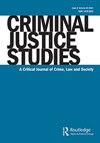行为问题早期发作的潜在类别分析:与预测整个人生过程中的冒犯行为的相关性
IF 1.1
Q3 OPERATIONS RESEARCH & MANAGEMENT SCIENCE
引用次数: 2
摘要
摘要研究表明,早期行为问题对于预测整个生命过程中的犯罪风险具有重要意义。然而,目前还没有任何研究来检验早期行为问题是如何聚集在一起的,以及这些问题如何预测整个生命过程中的冒犯行为。潜在类别分析用于识别包括儿童行为问题发作的行为类别:作弊、扰乱课堂、醉酒/吸毒、偷窃和打架。方差分析用于确定风险/保护因素的类别间差异。确定了各群体的年龄-犯罪曲线,以衡量其一生中的犯罪行为。结果表明,三类模型最适合数据(低EOBP、FDC、DCSF)。各组在风险/保护因素方面存在差异。年龄-犯罪曲线表明,被分配到DCSF组的参与者在青春期表现出更严重的犯罪,FDC和DCSF组在成年早期表现出更为严重的犯罪。识别儿童时期报告扰乱课堂、打架和偷窃的个人,可能会增加青少年时期更严重犯罪的风险。这可能会使他们面临在人生过程中遭遇陷阱的风险。本文章由计算机程序翻译,如有差异,请以英文原文为准。
Latent class analysis of early onset of behavior problems: relevance for predicting offending across the life-course
ABSTRACT Research has demonstrated the importance of early-life behavioral issues for predicting risk for offending throughout the life-course. However, there has yet to be any study that has examined how early behavior problems may cluster together and how these clusters predict offending across the life-course. Latent class analysis was used to identify behavior classes comprising the onset of the childhood behavior problems: cheating, disrupting class, being drunk/stoned, stealing, and fighting. Analysis of variance was used to identify between-class differences in risk/protective factors. Age–crime curves were identified for groups to measure offending throughout the life-course. Results indicated that a three-class model best fits the data (Low EOBP, FDC, DCSF). Groups differed in risk/protective factor profiles. Age–crime curves indicated that participants assigned to the DCSF group demonstrated more serious offending in adolescence and that the FDC and DCSF groups demonstrated more serious offending in early adulthood. Identification of individuals reporting disturbing class, fighting, and stealing in childhood may be at elevated risk for more serious offending in adolescence. This may place them at risk for encountering snares in the life-course.
求助全文
通过发布文献求助,成功后即可免费获取论文全文。
去求助
来源期刊

CRIMINAL JUSTICE STUDIES
OPERATIONS RESEARCH & MANAGEMENT SCIENCE-
CiteScore
2.80
自引率
5.60%
发文量
17
期刊介绍:
Criminal Justice Studies, a quarterly refereed journal, publishes articles that deal with substantive criminal justice and criminological issues. The journal welcomes all articles that are relevant to the issue of criminal justice, as well as those that may be outside the field but have relevancy to the topic of criminal justice. Articles that cover public administration, issues of public policy, as well as public affairs issues are welcome. The journal also publishes relevant literature reviews, research notes and summary reports of innovative research projects in criminal justice. Qualitative and quantifiable articles are sought mainly from academics and researchers in the field, though articles from professionals will also be considered.
 求助内容:
求助内容: 应助结果提醒方式:
应助结果提醒方式:


